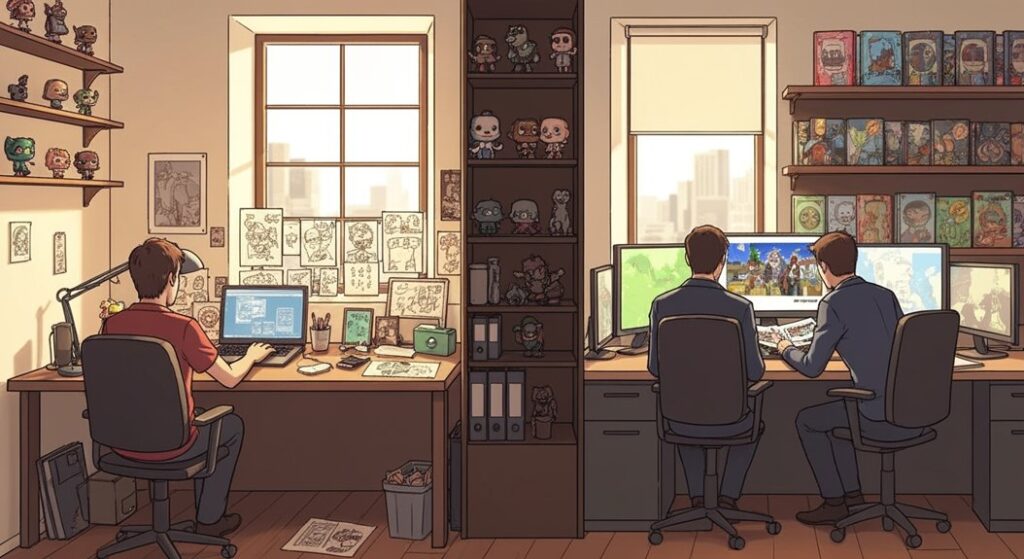
Marketing strategies for Indie game studios
Gain an edge in the indie game market with strategic marketing moves that go beyond social media—discover what could set your game apart next.


When you look at why indie games are different than mainstream games, it’s clear there’s more at play than just the size of the studio or the budget. Indie games are known for their creativity and willingness to break the mold, giving players unique experiences that mainstream games might not offer. Whether you’re a beginner curious about new stories or a veteran player seeking something fresh, indie games often reflect the diversity and passion of the gaming community itself.

The real magic of why indie games are different than mainstream games lies in the close connection between developers and players, resulting in innovative gameplay, heartfelt stories, and a sense of community that welcomes everyone. If you’ve ever wondered why indie games are different than mainstream games, it’s because they’re driven by bold ideas, community feedback, and a love for gaming that’s truly inspiring.
When it comes to indie games, creative freedom and risk-taking truly set them apart. Unlike mainstream games that often follow safe, familiar paths, indie developers in the gaming community aren’t afraid to experiment and push boundaries.
You’ll find indie games bursting with creative freedom—whether it’s through unique art styles, innovative gameplay mechanics, or unconventional stories that invite all kinds of players to get involved.
This spirit of risk-taking in indie games leads to fresh, surprising experiences that resonate with both beginners and veteran players.
If you’re looking for tips on discovering hidden gems or want to be part of a community that celebrates diversity and bold ideas, exploring creative freedom and risk-taking in indie games is the perfect place to start.
Indie games thrive on creative freedom and risk-taking, but budget constraints often shape how these unique experiences come to life.
In the world of indie games, every dollar counts, so developers find clever ways to solve problems, reuse assets, and focus on tightly scoped projects. Resourcefulness is key, making indie games a true celebration of creativity and ingenuity.
Without massive teams or big budgets, indie games rely on free tools, passionate communities, and the diverse talents of gamers everywhere.
Whether you’re just starting out or have been playing for years, indie games offer inspiring stories, helpful tips, and reviews that resonate with everyone in the gaming community.
One of the most exciting things about indie games is their unique art styles and visual identity. Unlike big studios, indie developers have the creative freedom to experiment with bold visual choices, making indie games stand out in the gaming community.
From hand-drawn animation to pixel art and surreal designs, indie games showcase a stunning variety that reflects the personal vision of their creators. This individuality not only gives each indie game a memorable identity but also creates a diverse landscape where every player can find something that resonates with them.
Whether you’re new to indie games or a long-time fan, exploring these distinctive visual styles is a great way to discover hidden gems and connect with the passionate community behind indie games.
In the world of indie games, storytelling approaches and narrative depth take center stage, offering something truly special for the gaming community.
While blockbuster games often focus on cinematic spectacle, indie games use creative storytelling approaches that invite players to uncover narrative depth through gameplay and environmental clues.
This unique style allows both beginners and veteran players to experience stories that are personal, surprising, and thought-provoking—qualities that highlight the diversity of the gaming community.
If you’re looking for tips on exploring narrative depth or want reviews of the best storytelling approaches in indie games, there’s never been a better time to dive in.
Whether you’re new to gaming or a longtime fan, the inclusive and passionate world of indie games is full of stories waiting to be discovered.
Indie games have become a powerful force in the gaming community, especially when it comes to niche audiences and community engagement. One of the best things about indie games is how they bring fans together, creating vibrant spaces for niche audiences and community engagement where every player’s voice counts.
Whether you’re a newcomer or a seasoned gamer, indie developers value your feedback, often shaping their games based on your input. This focus on niche audiences and community engagement means you’ll always find people who share your unique passions and interests.
Want to dive deeper? Join forums, share your own reviews, and connect with fellow players—because in the world of indie games, niche audiences and community engagement aren’t just buzzwords; they’re at the heart of what makes gaming so special.
If you’re passionate about innovation in gameplay mechanics, the indie gaming scene is where you’ll discover some of the most creative experiences available.
Innovation in gameplay mechanics isn’t just a buzzword here—it’s a driving force behind unique control schemes, surprising storylines, and out-of-the-box challenges that invite gamers of all backgrounds to think differently.
Indie developers thrive on innovation in gameplay mechanics, bringing fresh ideas to the table without the constraints of big studios.
Whether you’re a beginner looking for something new or a veteran player searching for your next favorite title, exploring these inventive games can inspire and unite the gaming community with stories, tips, and reviews that celebrate our shared love for creativity.
When exploring the world of indie games vs mainstream titles, one standout difference is the size and collaboration of their development teams. Indie games are often crafted by small, tight-knit groups or even a single developer, which leads to a unique sense of creativity and community.
This smaller team size means that indie games can benefit from faster decision-making and a collaborative atmosphere, where every voice truly matters.
On the other hand, mainstream titles are usually built by large teams with specialized roles. While this brings impressive resources and polish, it can sometimes slow down communication and limit creative flexibility.
Still, both indie games and mainstream titles contribute to the diverse gaming community, offering experiences for every type of player. Whether you’re a newcomer or a long-time gamer, understanding the difference in development team size and collaboration can help you appreciate the passion and dedication behind every release.
When it comes to marketing strategies and distribution channels in the gaming community, there’s a world of difference between indie games and mainstream titles. The gaming community is incredibly diverse, and so are the ways games reach players.
Big publishers in the gaming community often use large-scale advertising, high-profile partnerships, and a strong retail presence to make sure their games are everywhere. Meanwhile, indie developers in the gaming community turn to social media, creative grassroots campaigns, and digital storefronts like Steam to connect directly with players.
Many players discover indie gems through word of mouth, gaming forums, and curated platforms, making the journey of finding new favorites a unique experience for everyone.
Whether you’re new to gaming or a seasoned player, exploring these different marketing strategies can help you uncover hidden gems and connect with the passionate people who make the gaming world so vibrant.
One of the most exciting aspects of indie games is how closely they connect with the gaming community through player feedback and iterative development. Unlike mainstream games, which often follow strict release schedules, indie games are shaped by the voices of gamers at every stage.
Indie developers listen actively to player feedback, quickly rolling out updates and improvements based on real community input. This approach makes indie games feel more personal and dynamic, evolving in real-time to match what the gaming community wants.
Whether you’re new to gaming or a seasoned expert, sharing your thoughts can directly influence the direction of your favorite indie titles. This collaborative spirit highlights the diversity of the gaming community and shows just how powerful player feedback and iterative development can be in shaping the future of games.
If you’ve ever wondered why indie games are different than mainstream games, the answer lies in the heart and creativity that indie developers bring to the table. Indie games are different than mainstream games because they’re often crafted by passionate, small teams who pour their unique vision into every pixel and storyline. Unlike big-budget titles, indie games are different than mainstream games in the way they embrace innovation, experiment with gameplay mechanics, and truly listen to feedback from their vibrant communities.
What makes indie games stand out is the diversity within the gaming community they foster—players from all backgrounds can find something that resonates with them, whether it’s an emotional narrative, distinctive art style, or a fresh take on classic genres. If you’re new to gaming or a seasoned player looking for something outside the mainstream, don’t hesitate to dive into indie games for a truly personal and memorable experience. Plus, sharing your tips, reviews, and stories helps these games grow and makes the community even stronger!

Gain an edge in the indie game market with strategic marketing moves that go beyond social media—discover what could set your game apart next.

From creative risks to developer autonomy, find out what truly defines an indie game—and why the answer might surprise you.

Not all treasures are on the front page—discover hidden indie gems on Steam that will surprise and captivate you in ways you never expected.

Open the door to indie gaming with our top 7 beginner-friendly picks—discover which charming adventures you shouldn't miss next.

Before diving into the world of Stardew Valley mods on Mac, discover the essential steps you can't afford to miss for a flawless installation.

Pinpointing Stardew Valley’s top fishing spots is trickier than you think—discover the secret strategies that can transform your next cast.